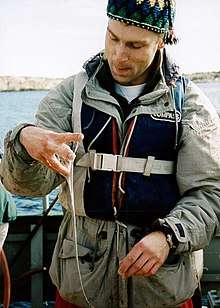Sea snot
Sea snot or marine mucilage is a collection of mucus-like organic matter found in the sea. The substance is described as "jello-like sheets of disease-carrying mucus" that holds a strong presence in the Mediterranean Sea and has been spreading into farther-flung waters.[1]

Causes
Sea snot forms when globs of marine snow coagulate into large globs that can span distances as large as 124 miles.[2] The mucilage has many components, including a wide range of microorganisms including viruses and prokaryotes, and exopolymeric compounds with colloidal properties.[3] Sea snot is also produced by phytoplankton when they are stressed.[4]
Effects
An increase in the amount of sea snot in the Mediterranean and other seas observed at least as early as 2009 may have been the result of climate change. Warmer, slower moving waters increase the production of sea snot and allow it to accumulate in massive blobs.[2] Sea snot was first reported in 1729 and has long been seen as a nuisance to the fishing industry and coastal populations.[2] Recently, sea snot has emerged not only as a nuisance, but as a major hazard. Globs of sea snot can harbor bacteria such as E. coli that threaten maritime flora and fauna as well as humans exposed to contaminated water. It can also coat the gills of sea creatures subsumed in it, cutting off oxygen and killing them.[2]
The Deepwater Horizon oil spill in the Gulf of Mexico created large amounts of sea snot. Scientists are not sure how exactly the spill caused so much sea snot to form, but one theory asserts that the sea snot could have been the result of a massive kill of microscopic marine life creating a "blizzard" of marine snow. Scientists worry that the mass of sea snot could pose a biohazard to surviving marine life in the area.[5] It is widely believed that the Sea Snot left by the spill directly resulted in the loss of sealife in the Gulf of Mexico based upon a dead field of deepwater coral 11 kilometers away from the Deepwater Horizon station.[6]
See also
- Mucilage – Polar glycoprotein and exopolysaccharide produced by nearly all plants and some microorganisms
- Marine snow – Shower of mostly organic detritus falling from the upper layers of the water column
References
- David Gilson (October 13, 2009). "Sea Snot: Climate Change Gets Gross". Retrieved 2013-05-20.
- Christine Dell'Amore (October 8, 2009). "Giant, Mucus-Like Sea Blobs on the Rise, Pose Danger". National Geographic. Archived from the original on 12 July 2012. Retrieved 2010-09-24.
- Roberto Danovaro; Serena Fonda Umani; Antonio Pusceddu (September 16, 2009). "Climate Change and the Potential Spreading of Marine Mucilage and Microbial Pathogens in the Mediterranean Sea". PLOS ONE. 4 (9): e7006. Bibcode:2009PLoSO...4.7006D. doi:10.1371/journal.pone.0007006. PMC 2739426. PMID 19759910.
- Xeni Jardin (September 24, 2010). "Sea snot explodes near BP spill disaster site, threatening marine ecosystem". Retrieved 2013-05-20.
- Christine Dell'Amore (September 23, 2010). "Sea Snot" Explosion Caused by Gulf Oil Spill?". National Geographic. Retrieved 2010-09-24.
- http://www.nature.com/news/2011/110413/full/472152a.html